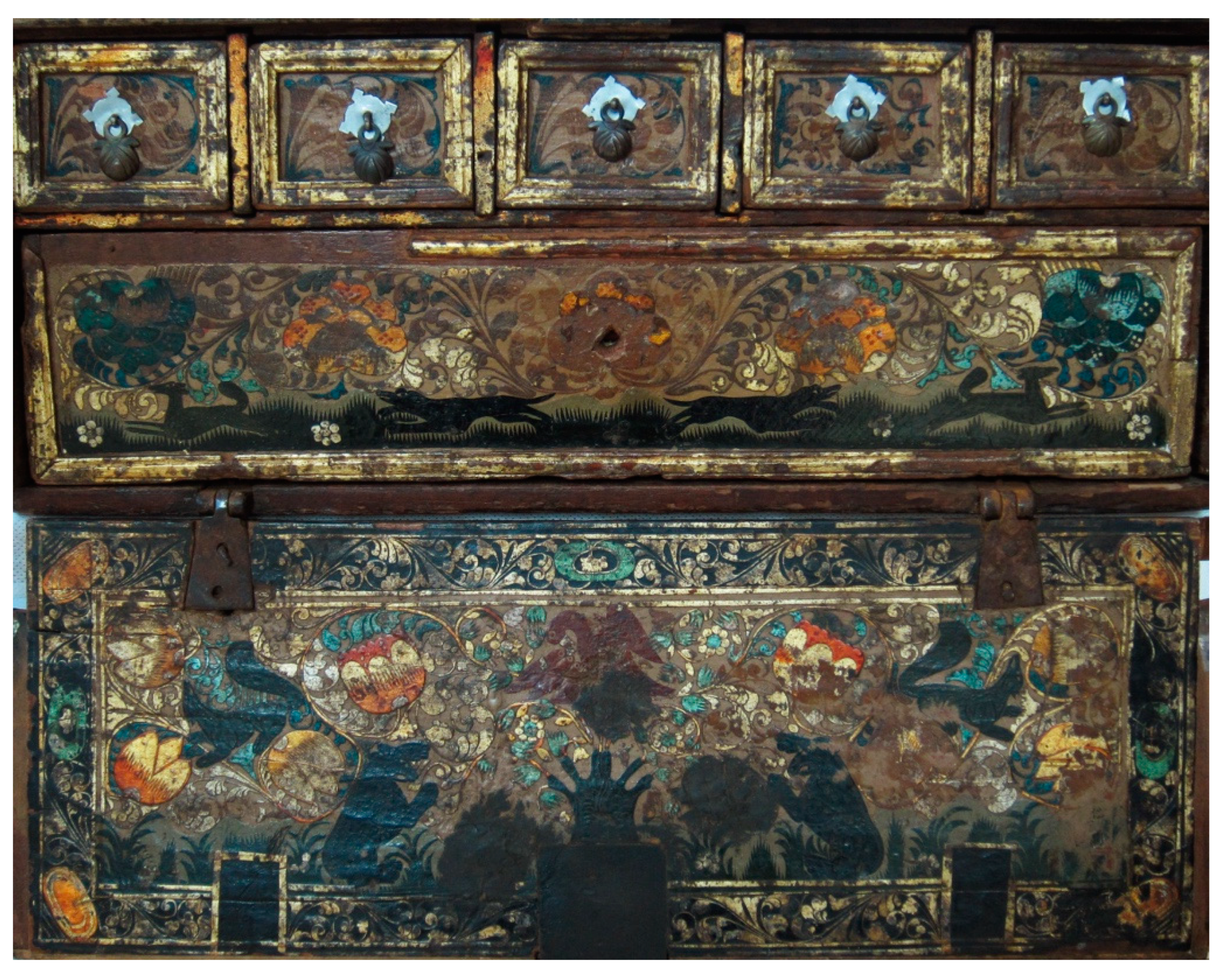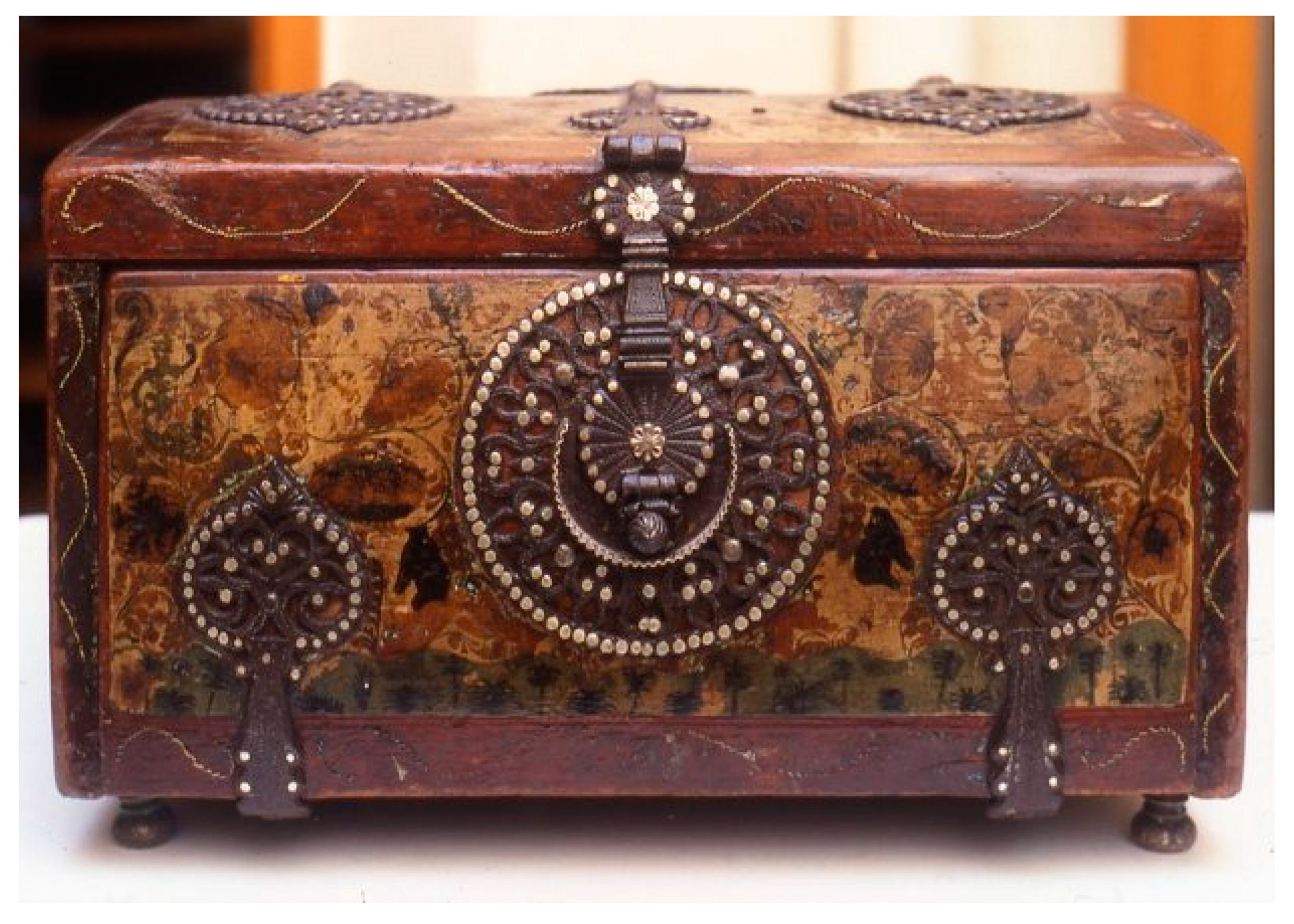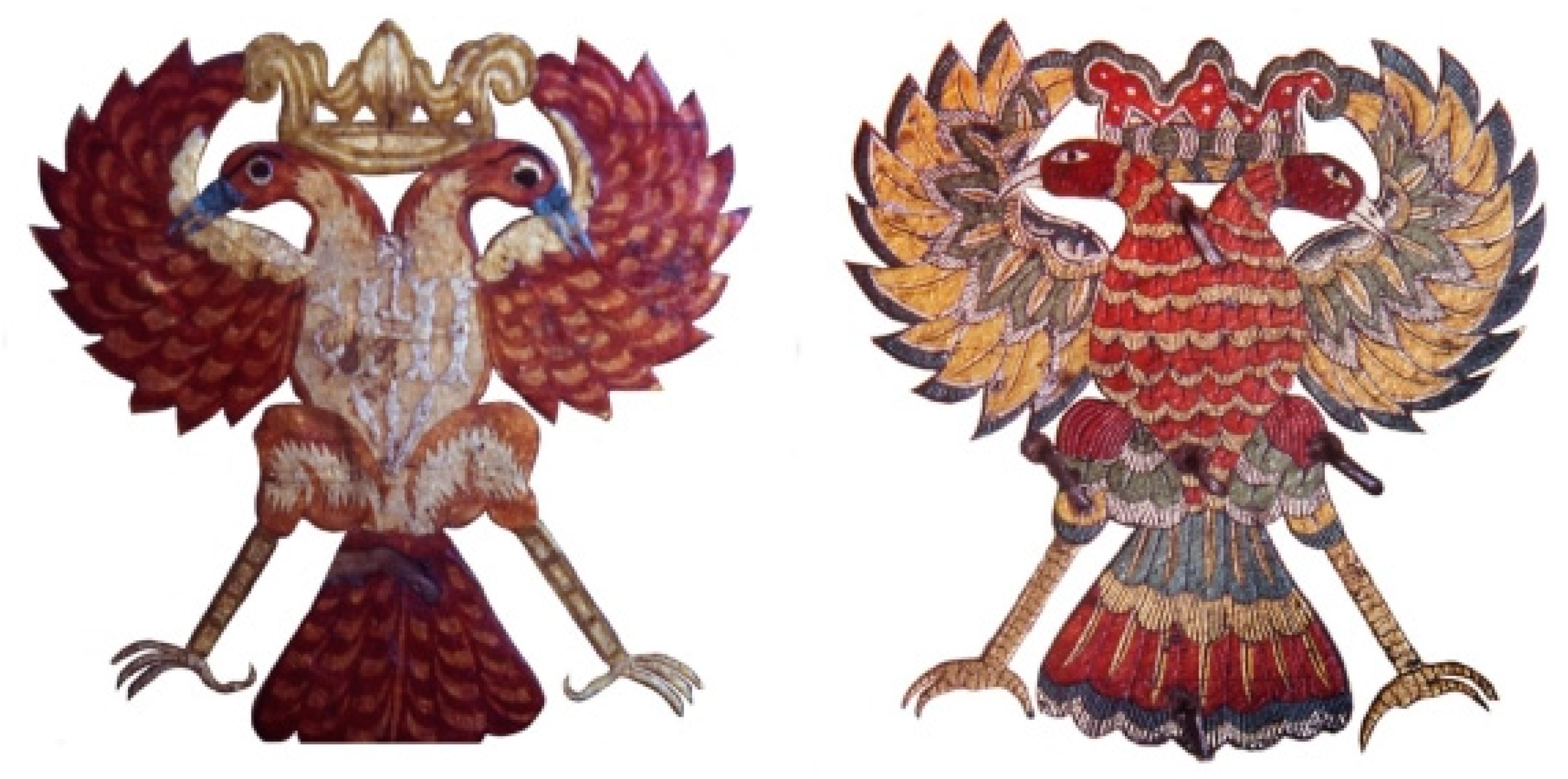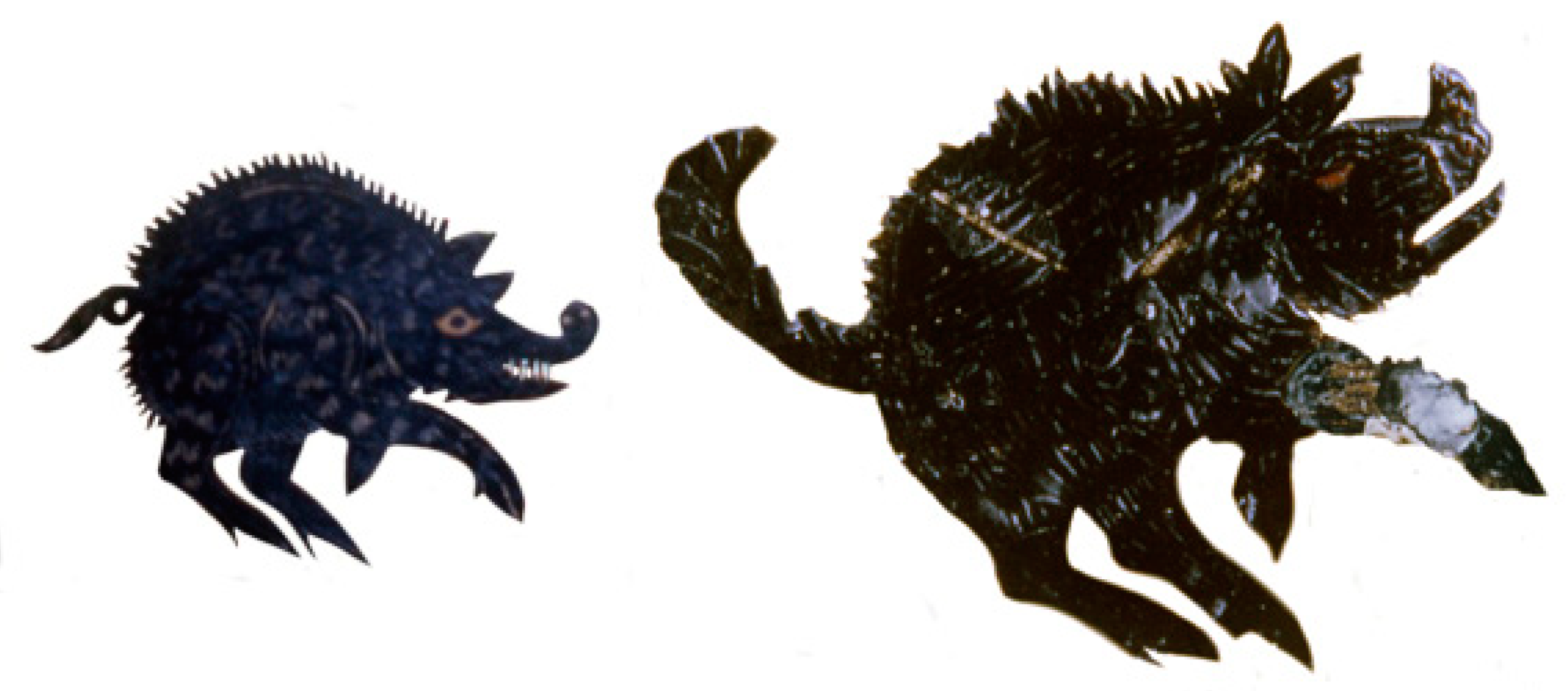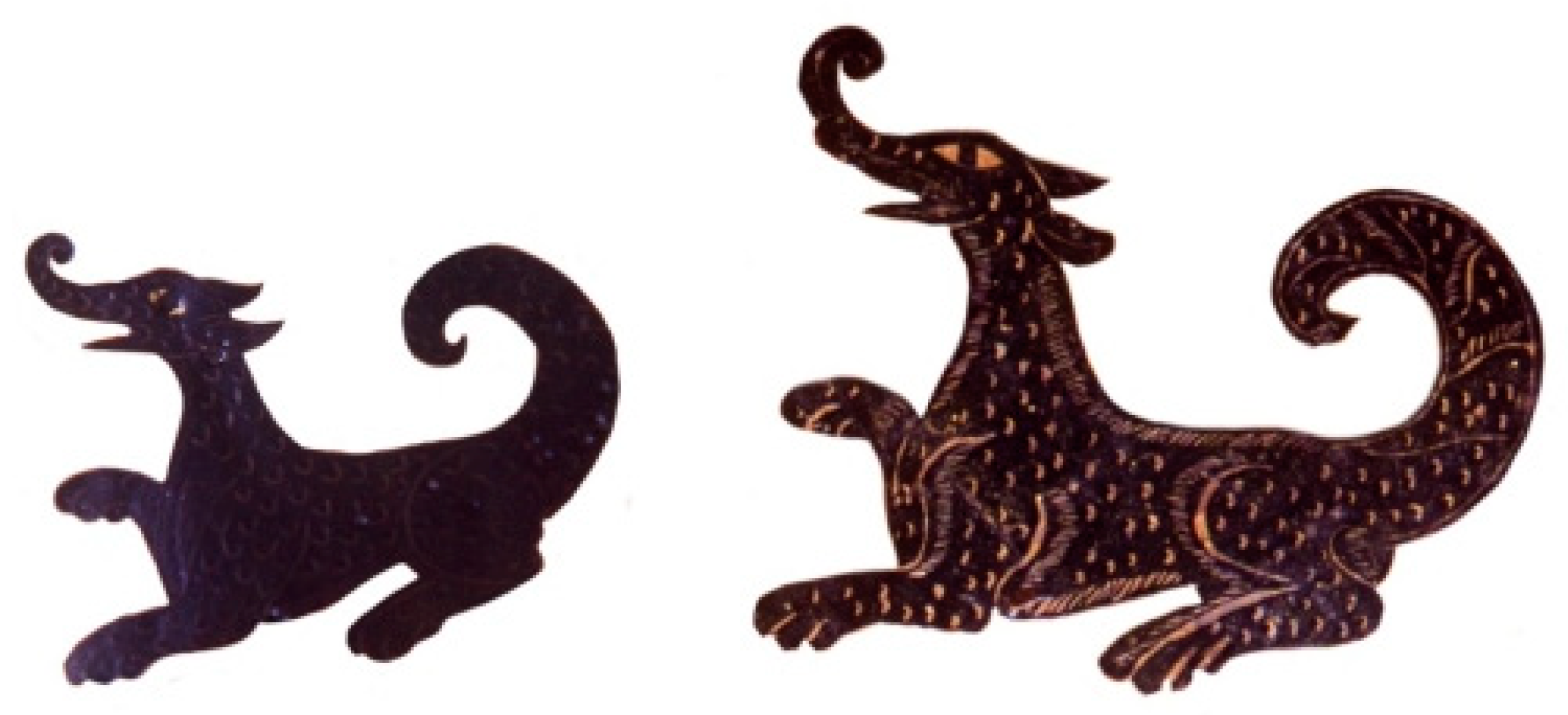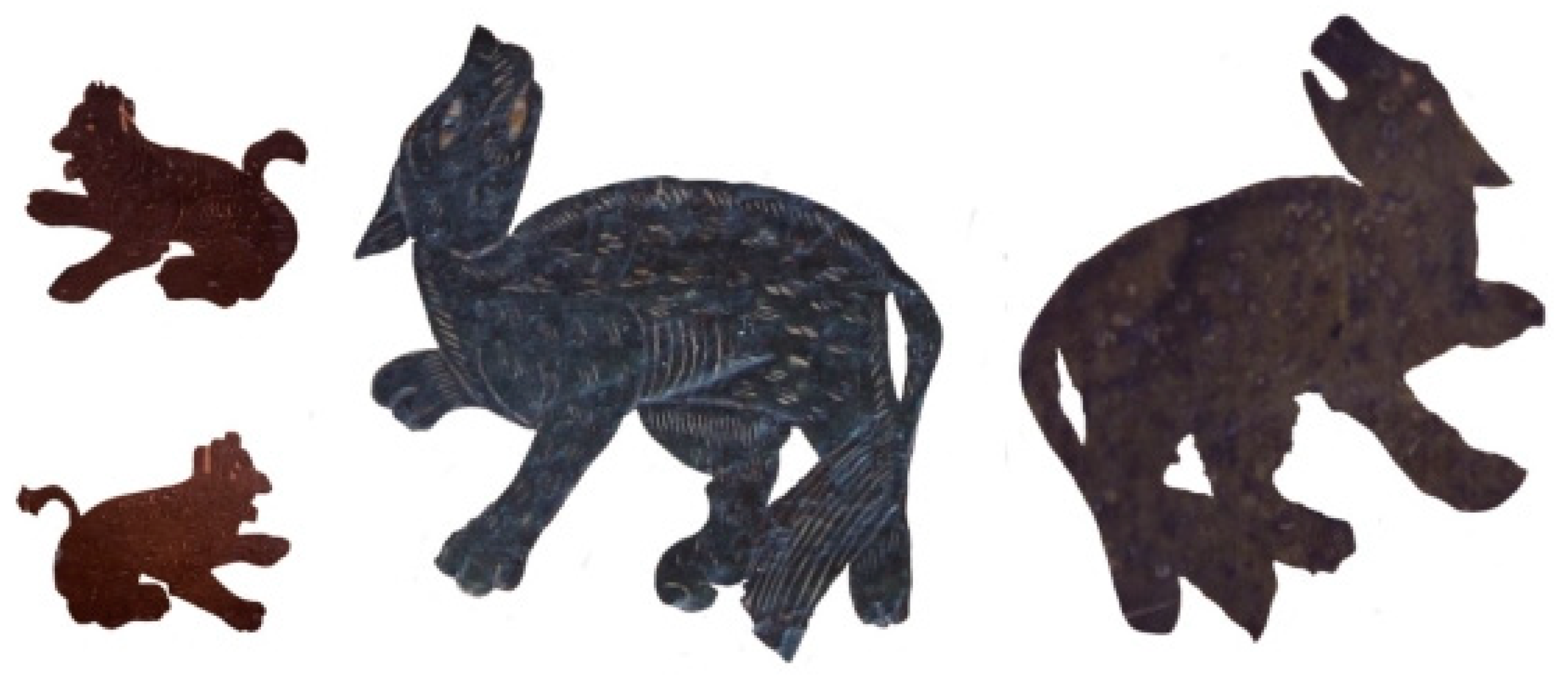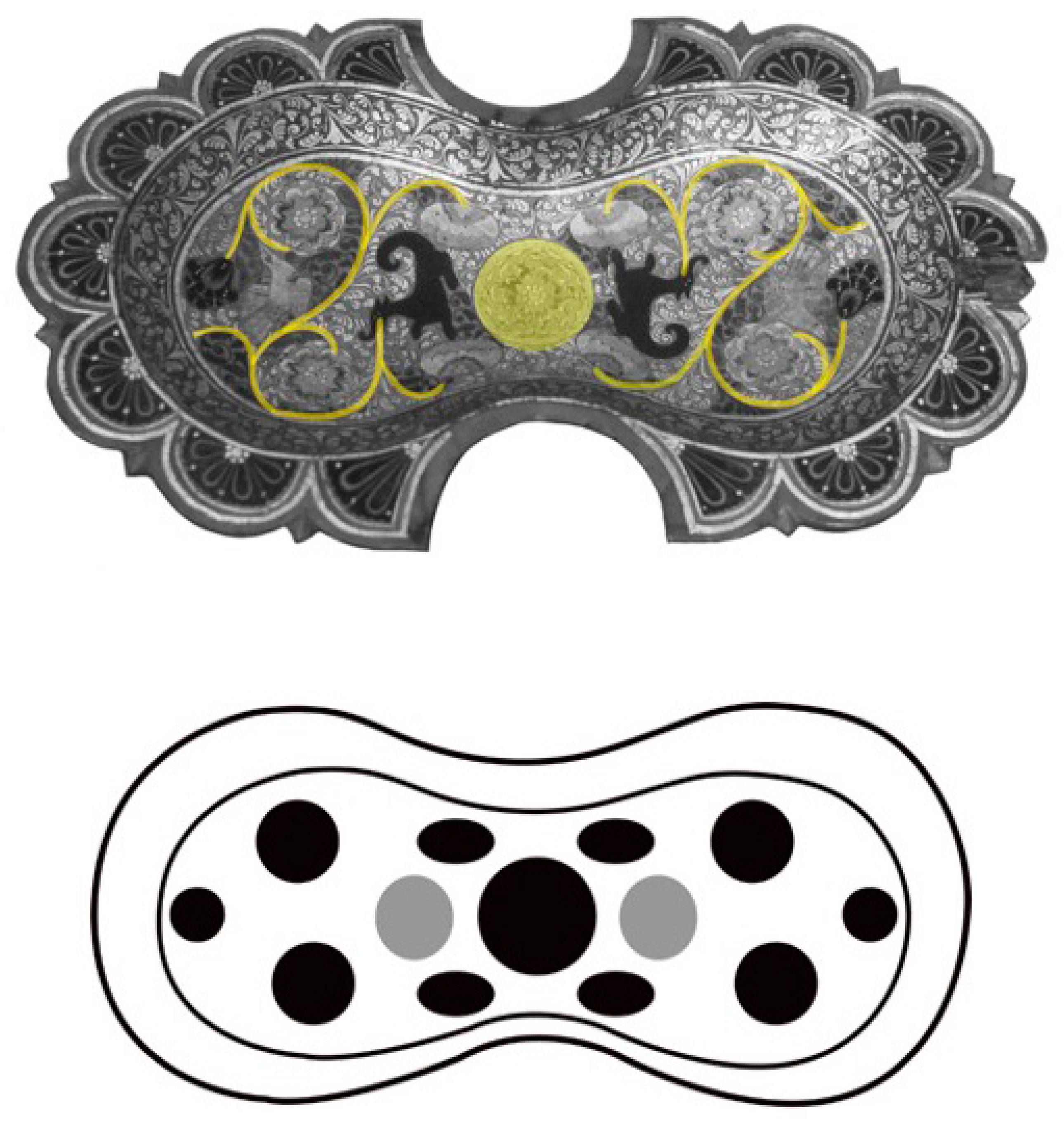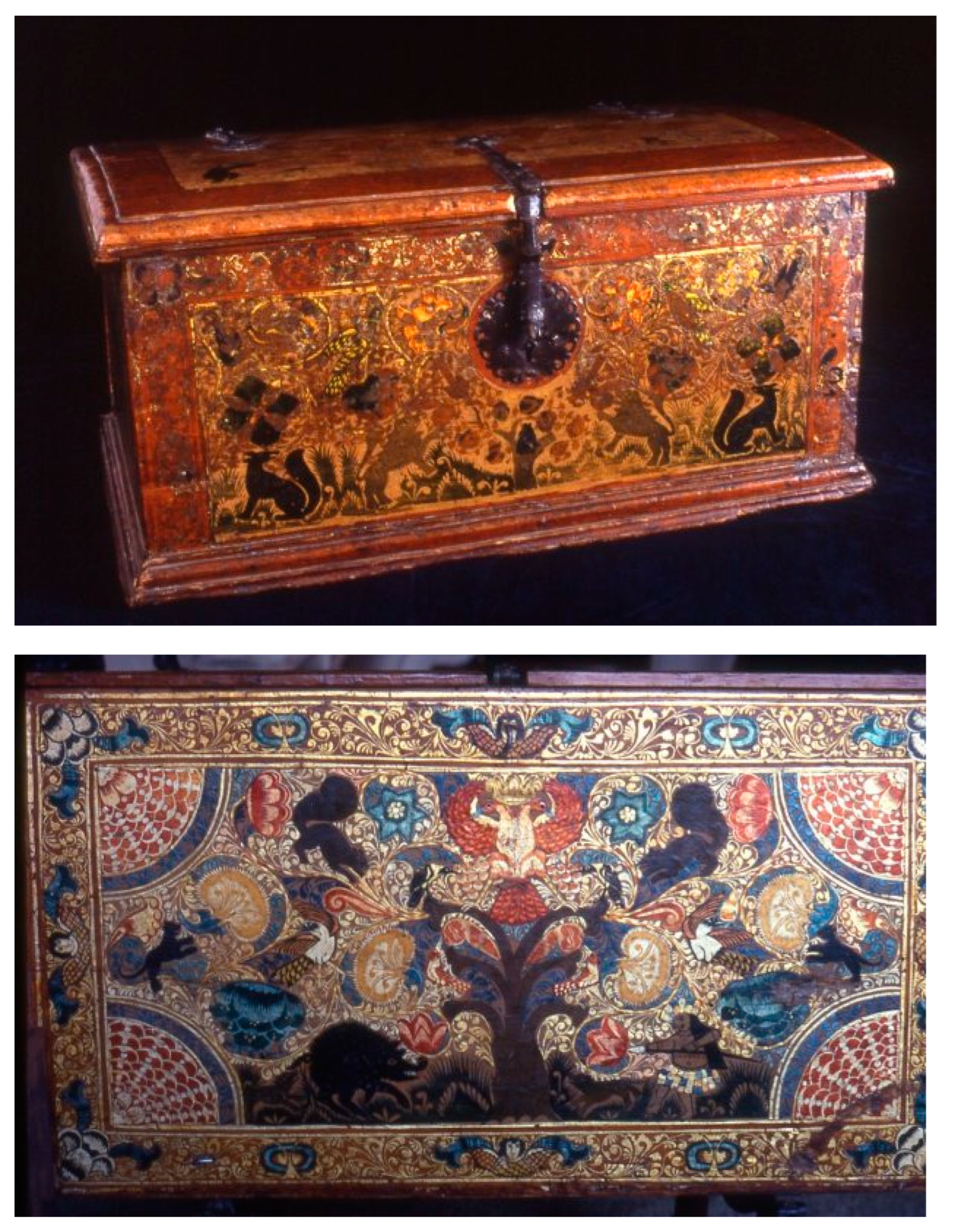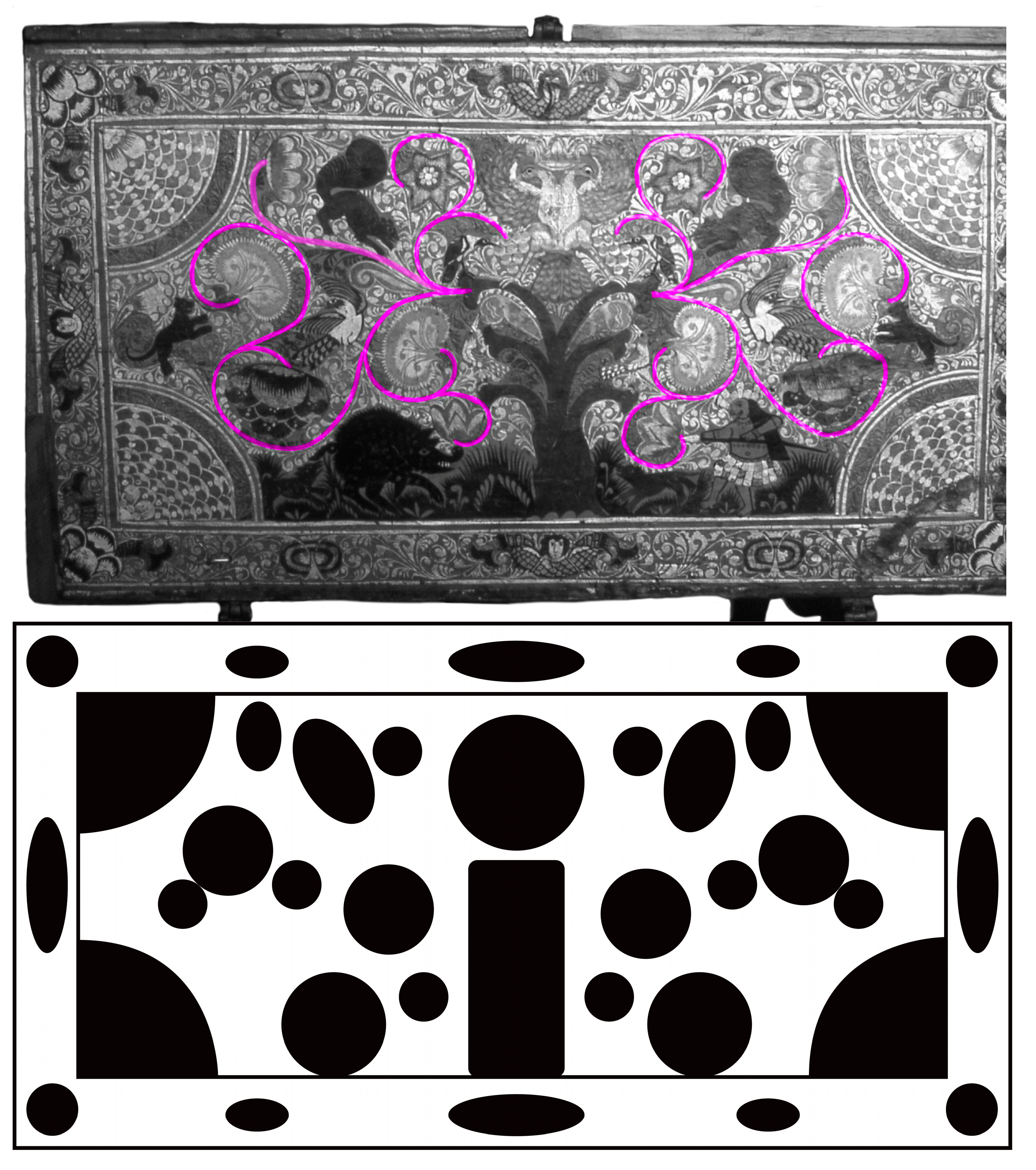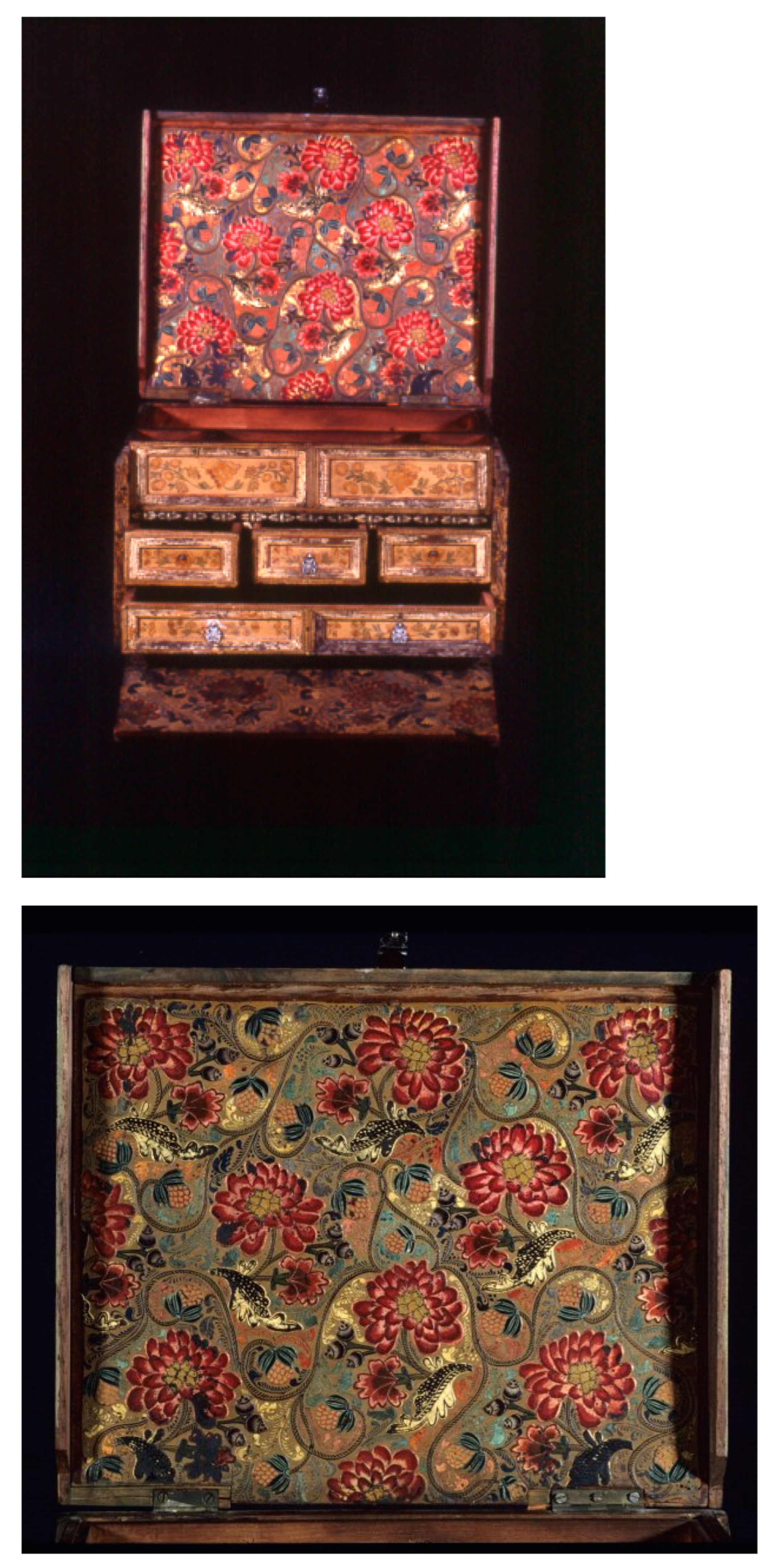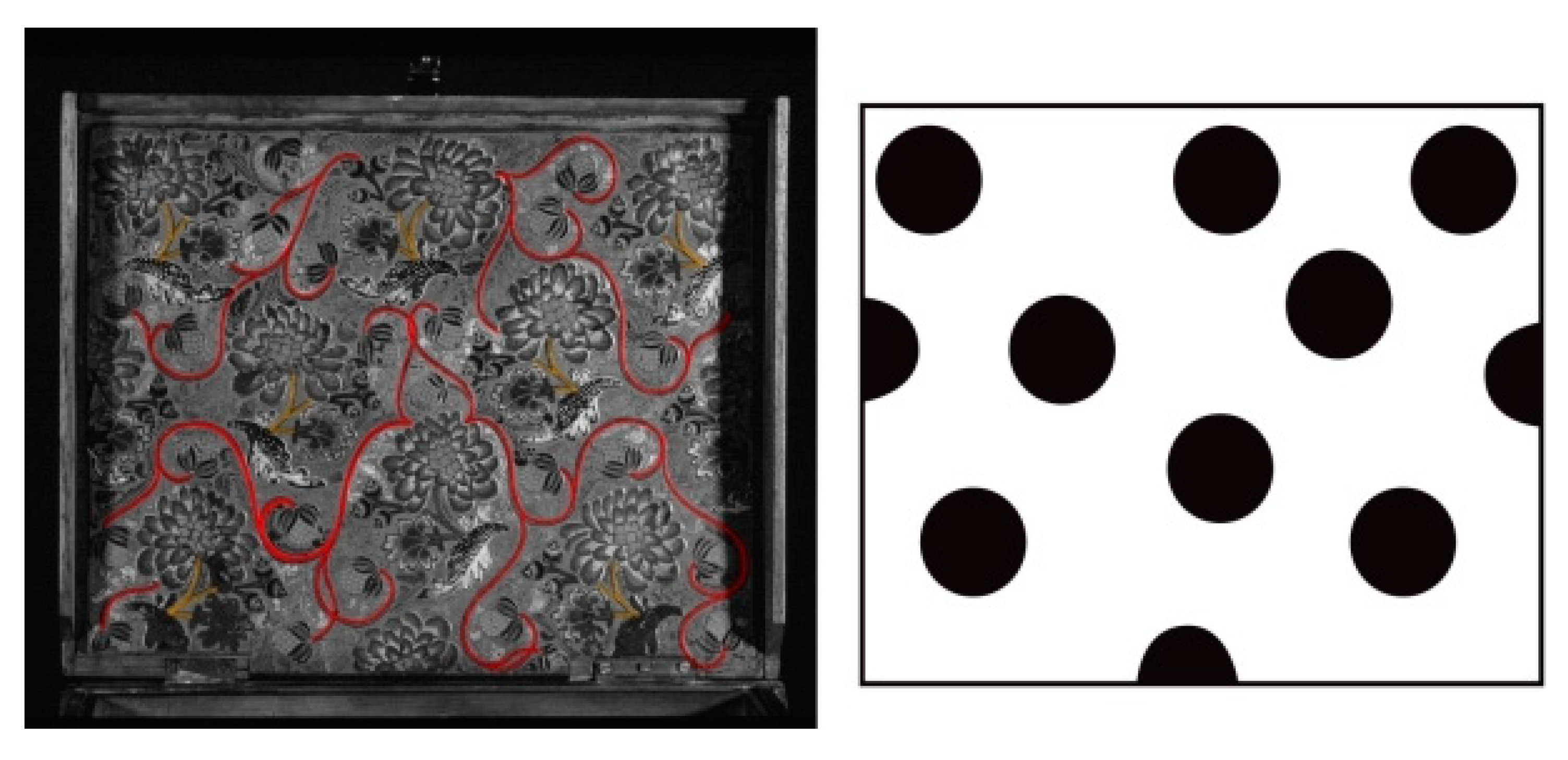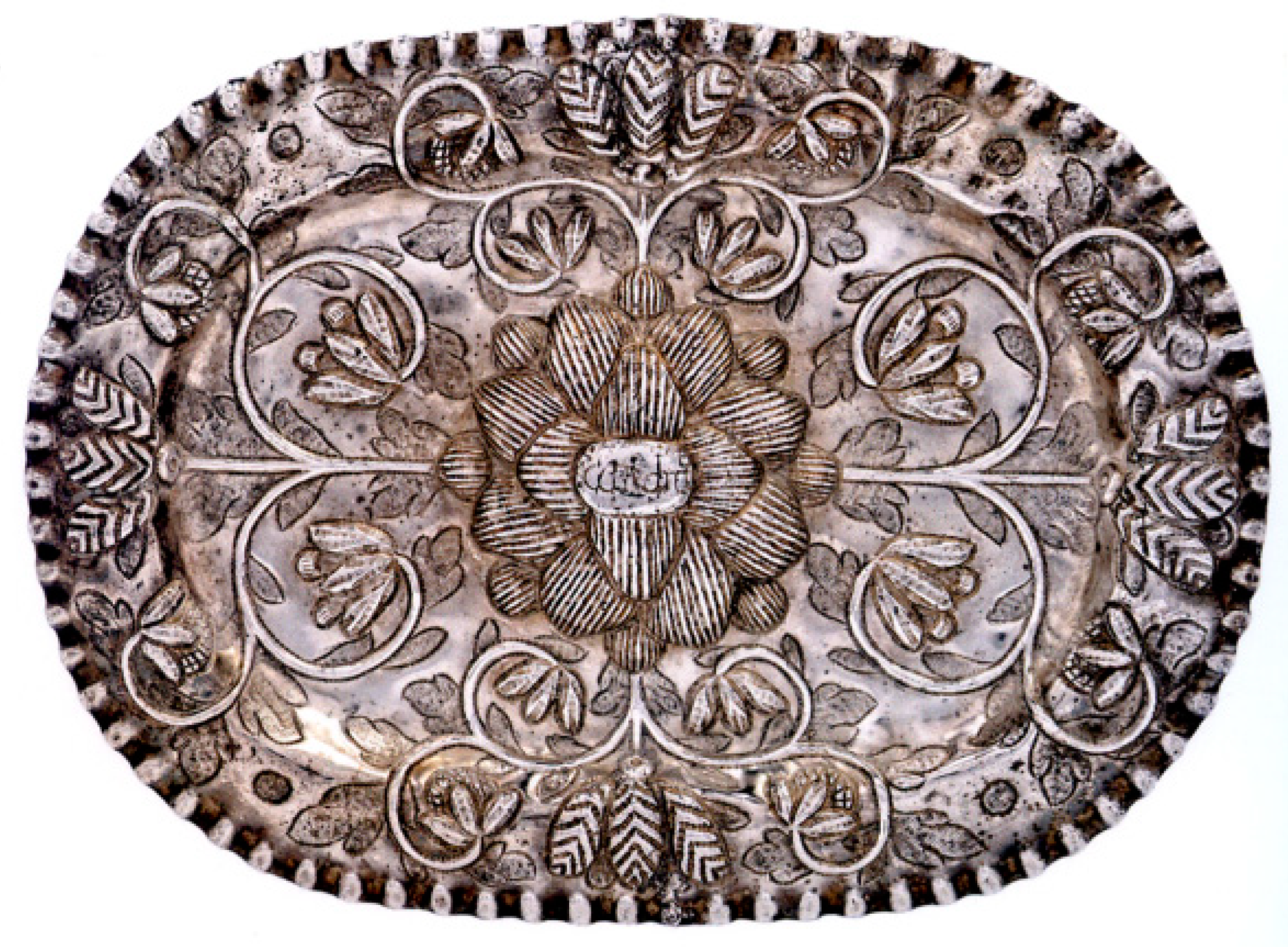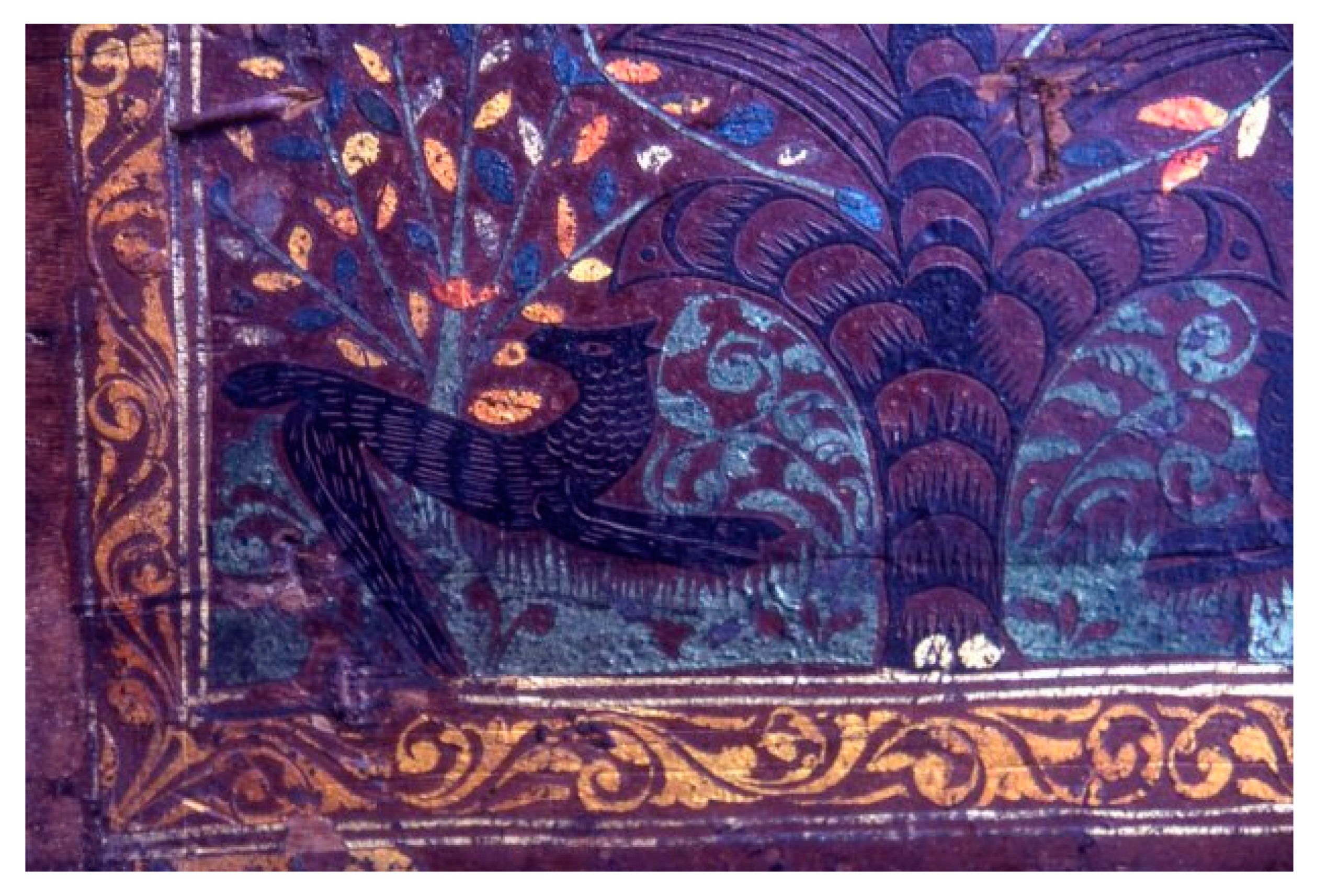1. Barniz de Pasto, an Art Linked to the Professional Field of Painting
Recognized as an Intangible Cultural Heritage of Humanity by UNESCO, barniz de Pasto encapsulates a tradition that spans over five centuries. This wide, diverse, and complex art form is characterized by its techniques and variations, which are generated by the exchange of knowledge and materials. It incorporates images which reflect cultural values, adapting and transforming at different moments in history.
The formal, aesthetic, and technical values of barniz de Pasto works can be appreciated in practical objects in which various trades such as carpentry, silversmithing, and blacksmithing also converged. The collaboration between these trades gave rise to unique works with new artistic values in the Andean tradition, particularly in Nariño, in southern Colombia, and in northern Ecuador.
This art form predates the arrival of the Spaniards in the Americas and was known by the population of a vast territory. Thus, for today’s society and for barniz de Pasto experts and current scholars, these works will always reveal something unknown and unstudied, imbued as they are with endless potential for new knowledge.
Barniz de Pasto is made with resin obtained from the Elaeagia Pastoensis plant, traditionally referred to as mopa-mopa; it was known throughout the Andean region and was typically used to cover various wooden objects. The technical and artistic skills needed to work with barniz de Pasto required specialised mastery.
This art was mainly produced in workshops around the cities of Pasto and Quito, and objects were in demand by the clergy, the state officials, and the elites. It depicted scenes from daily life, moral and religious scenes, government symbols, and a great variety of ornaments. Its wide range of images depicts local and non-native animals, fantastic birds and flowers, and an extensive repertoire of geometric and organic figures (see
Figure 1). These images were created using hybrid techniques [
1], blending Indigenous and Spanish traditions, and have been constantly changing and adapting to other cultures due to multiple forms of cultural exchange [
2].
From the sixteenth century, the art of
barniz de Pasto was recognized by analogy as craftmanship similar to that of the professional painter’s field, taking into account several of its characteristics, which are noted by Antonio Palomino in his treatise
El museo pictórico y escala óptica [
3], already discussed by the historian Sonia Ocaña in her work [
4]. Palomino mentions the fresco and tempera wall painter, the oil on panel or canvas painter, the embroidery and fabric painter, the porcelain painter, the inlay painter, and the painter of ceramics, iron, and glass. To this diverse list of specialties, the sculpture painter can be added. It is therefore understood that those who painted and varnished the various objects of use with
something that sticks were recognised as varnish painters called
llimpec, i.e., ‘painters who paint on walls and on
quero and matte’ [
5], according to Felipe Guamán Poma de Ayala in his book
Nueva Crónica y Buen Gobierno.Additionally, in references from the 16th to the 18th centuries, documentation from different archives describes the professional who worked with
mopa-mopa as a ‘painter of
barniz de Pasto’ and the works that were produced as ‘paintings of
barniz de Pasto’. Historian Laura Vargas Murcia has transcribed a document from 1738, a ‘
Juicio ejecutivo por pinturas de barniz de Pasto’, which is kept in the Archivo Central del Cauca in Popayán. This document not only recognizes this art as ‘paintings of
barniz de Pasto’, but also recognizes Casimiro Benavides, Juan de Benavides, and Felipe Pérez de Zúñiga [
6] as painters of
barniz de Pasto. Later, in the 19th century, in 1849, Crisanto Granja was identified as the chief master of the ‘oil and
barniz painters’ [
7].
As was the case with many types of manufacturing work in New Spain, the model of artistic teaching established in
barniz de Pasto workshops followed the traditional structure that existed in Spanish workshops, specifically those related to the art of painting. This model was introduced to the Americas, where there is clear evidence that both Indigenous people and Spaniards shared activities in various trades. Apprenticeship contracts document the entry of Indigenous children to painters’ workshops
1. Crossbreeding continued throughout the 16th and 17th centuries, although by the 18th century there were some changes, and, in the case of
barniz de Pasto, the workshops were mainly made up of Indigenous and
mestizo (people of mixed European and Indigenous descent) workers
2.
As in Spain, the details of the work of the painter and the apprenticeship process were legalized by contracts registered in a notary’s office or a verbal agreement
3. Although we do not have data on
barniz de Pasto workshops specifically, information can be deduced by reference to other related sources, for example the training of painters and silversmiths that required good drawing skills.
One of the basic requirements taught by a master painter in Spain was to recognize and become familiar with artists’ materials: to learn how to prepare them, to begin to learn some technical draftsmanship skills to master the ‘symmetry and compartmentalization of the parts’
4 [
9], and to learn how to copy and colour. At a later stage, the apprentice also had to learn to read, write, and count
5.
The forms and the organization of the figures in barniz de Pasto could come from many sources related to the painter’s profession, for example, the commerce of prints, drawings, and utilitarian objects, all of which could provide examples of how to solve problems of surface organization and construction of visual patterns.
The apprentice painter acquired drawing skills [
10] and learned how to represent formal decorative elements, considered of lesser importance than the ornamental figures that are referenced by some writers of the time, such as Vicente Carducho, Jusepe Martinez, Francisco Pacheco, and Sebastian Serlio among others [
8].
This would have been ideal training to become an artisan painter of barniz de Pasto, but this is unlikely to have happened often. However, the mere fact of receiving the most basic education in the painters’ craft allowed Creoles (people of mixed European and Black descent), Indigenous, and mestizos to develop skills and structure the surfaces they were going to work on with great artistic sensitivity.
In Spain, professional painters, whether they were wall painters, painters on panel or canvas, or painters of sculpture, were trained in draftsmanship and in the mastery, to some extent, of mathematics and geometry
6.
The importance of drawings and prints, including manuals for learning to draw [
11], is well known from the 16th century. The most appropriate shapes and themes were carefully selected as resources and pedagogical models in workshop practices ‘following a strategy that goes from simple to complex and from contour line to volume’ [
12]. José Manuel Mantilla
7 highlights that it was necessary to know the geometry and volume of the figures to break down the forms into their basic structures. In other words, the knowledge of geometry was fundamental to the practice of drawing. These exercises forced the painter to consider the space or surface, the graphic quality of the drawing, the geometric construction of a figure, and the different strokes needed to define parts and directions. The reference image was appropriately chosen according to the intention behind the work, and the graphic sources facilitated the creation of composition, expression, and movement [
13].
In the absence of extensive documentary sources that would allow us to know in some detail the artistic practice and the training process in the workshops, which was undoubtedly a traditional training from master to apprentice, it is important to consider what was recommended by the treatises on painting at the time. These books contained not only the knowledge and personal contributions of the respective authors, but also a way of practising the craft which came from long tradition and was rooted in the craftsmen’s memory and their practical processes. The authors of the treatises were typically senior masters of their trade, providing both technical and speculative data that served as guidance in the exercise of the profession and which were taken from the knowledge of the trade that existed in Spain before the treatise was written. In the great majority of cases, this is the knowledge that would have been carried to and applied early on in the new territories
8 [
14].
Treatises often stressed the importance of drawing skills. The painter Vicente Carducho (1576–1638) in his book
Diálogos de la pintura, written in 1633, highlights how paintings are perceived when a good drawing is not referenced, saying that they are works “of bad proportions, without grace or understanding [
15]”. However, he clarified that with the use of colour, works could give a favorable impression.
Other prominent painters also included in their treatises important reflections on drawing, such as the Aragonese painter Jusepe Martínez (1600–1682). In his treatise,
Discursos practicables del nobilísimo arte de la pintura, among the first topics he deals with is that of drawing and the “ways to create it with good imitation”. He states that this is a very necessary activity of the trade, which is mastered through practice, starting by copying single figures taken from prints, then copying more difficult images such as a complete tableaux. Afterwards, the painter would draw from life following different steps using charcoal and black or red pencil. To create works of invention and not imitation, the painter had to practice more complex exercises such as on symmetry, perspective, space, and colour. According to Martínez, in order to advance, one must review, “study it a lot, and from there move on to consider the correspondence between the parts, and from them to the whole. This correspondence is symmetry [
16]”. He used Vitruvius, Dürer, and other admirable masters as examples of artists who had surpassed the use of compass and ruler, and reviewed them in his text.
At the same time, painters in Spain were not only dedicated to drawing and painting religious or historical themes, but also developed drawings in the field of ornamentation, as Francisco Pacheco (1564–1644) points out in El arte de la pintura published in 1649. In the first two books or chapters of his treatise, he collates artists’ knowledge to date and outlines other ideas on the art of drawing and painting as technical processes, the creation of forms, and materials.
In the third book, which deals with practice, he addresses other subjects that also interested painters, such as the representation of flowers, fruits, and landscapes. These secular themes were popular during his time. Unlike religious or political themes, which were given greater importance, “the painting of flowers from nature in springtime is entertaining; and some have had eminence in this part, particularly in Flanders”. Themes such as spring and allegories where plants were present, details such as garlands, and wall borders with flowers and fruits within scrollwork were incorporated in artistic representations and were very popular. Painting flowers and fruits had its own degree of difficulty. Not all painters can have an impact on or move viewers by painting these subjects. The opinion of many painters was that these were not minor details and should be incorporated more frequently in teaching painting [
17].
Considering the above references, it can be supposed that Spaniards brought from Spain some knowledge and experience of the craft governed by ordinances and regulations that they put into practice in the New World. This knowledge is stored in people’s memories and applied practical skills. Most treatises in Spain were professional books that collated collective knowledge—in this case, the knowledge of painters—and were also intended to prevent knowledge from being lost. Authors made significant contributions, providing both technical and speculative data that served as guidance in professional practice [
18]. What this means is that the knowledge of the work existed in Spain before the treatise was written. The fact that the treatises include themes associated with ornamentation with the representation of flowers is relevant to this reflection since they are fundamental to structuring the image in
barniz de Pasto.
It is therefore understood that painters who had practiced in Spain, upon arriving in America, practiced, transmitted, and applied the principles of their art. They also established workshop practices to teach how to draw using prints, models and patterns, some trade books, and certain tools such as rulers, compasses, and machines to create perspective drawings
9. Painters—whether they painted walls, sculptures, or canvas—who may have joined the workshops of the
barniz de Pasto painters early on, developed particular artistic practices and skills that affected production in the 16th, 17th, and part of the 18th centuries. By the end of the 18th century, the designs of artistic works using
mopa-mopa became simpler as knowledge of drawing, control over form, and composition was lost, indicating a more intuitive rather than professionally skilled work. This is why in 1777, under the administration of Viceroy Manuel Antonio Flores (1776–1782),
Instrucción general para los gremios de todos los oficios10 was introduced in New Granada and the city of San Juan de Pasto. These guidelines from the Spanish state sought to revive a great deal of training across the fields within each of the trades and thus reestablish their quality and promote industry. They also proposed the establishment of overseers to regulate the training of artisans beginning at the apprenticeship stage and proposed courses in arithmetic, geometry, and algebra oriented to the needs of each artistic activity. This was proposed because works were not well executed: they were very basic and elementary in their configuration and were lacking with respect to composition, balance, the management of symmetry, the control of surfaces, and the creation of centers and tension points
11.
2. Barniz de Pasto, a Recursive Art in Connection with Other Professions
On the other hand, it must be acknowledged that the painter of barniz de Pasto did not construct the whole object. The barniz de Pasto coating had to be adapted to the supporting object and its interior and exterior surfaces. The vast majority of the objects were made of wood including coffers, cabinets, lecterns, and cabinets. Sometimes the object was designed before the varnish was applied and sometimes afterwards, meaning that the painter of barniz de Pasto had to adapt to the situation. Objects included cabinets with different designs, small writing desks, boxes, sewing boxes, coffers, wooden cups, trays, plates, candlesticks, lecterns, and a variety of containers, totumas and calabazos (dry gourds used as containers for liquids and fruits). These wooden objects with their locks, hinges, and other accessories were made by carpenters, blacksmiths, and silversmiths, which indicates that there were components and materials that came from different workshops and masters from different professional fields. Before covering a cabinet, for example, with mopa-mopa, the barniz de Pasto painter had to make a plan first, depending on the situation, with the carpenter, the blacksmith, or the silversmith.
Looking at the art pieces themselves, it is clear that once the wooden object was made per the instructions of the client, the carpenter would not install the ironware, but rather pass the cabinet along to the
barniz de Pasto painter for its coating. The painter could then develop his artistic plan, using varnish to mark where the hinges, the lock plate, and the hasp would be placed (
Figure 2). Sometimes, both the carpenter and the blacksmith respected the indications, but in other cases they placed the iron fittings elsewhere. Not only did this affect the surfaces but also the object’s iconographic plan. This could happen if the lock was placed on top of an important and relevant element of the composition. On the other hand, when the varnish painter received the complete, finished object, with all the accessories working, he could proceed with covering the remaining surface area, adapting his formal and compositional design according to the conditions of the completed object. The other aspect to consider was the client’s request, who may have had notions of drawing and an artistic sense acquired as part of his own training. In commissioned works with specific requirements represented by graphic illustrations, the varnish painter had to know how to interpret and place them appropriately on the surfaces of the objects
12.
Practical objects may have had different finishes—whether inlaid, embossed leather, painted, carved, or covered in barniz de Pasto—but they all share, in general terms, figures and iconographies.
The possibilities and limitations of the resin, which became a coloured membrane that could be cut into different shapes, allowed for a schematic formal model that remained constant for a long time, with images repeated over time, for example, similar animals, flowers, and ornaments, such as images of dogs, monkeys, parrots, dragons, wild boars, and fantastical flowers, among others. The repetition of the image in one or another object, with different uses, did not affect the value of the work, as long as it responded correctly to a specific commission (see
Figure 3,
Figure 4,
Figure 5,
Figure 6,
Figure 7,
Figure 8 and
Figure 9).
3. Structure and Organization of the Surfaces Worked with Barniz de Pasto in the Cases of a Basin, a Chest and a Cabinet
This paper began with the ways in which barniz de Pasto artists assumed formal and organizational control over the surfaces of their art pieces. Taking some representative works from this cultural context, we will reflect on the overt and underlying forms, such as lines, axes, reticles, frames, symmetries, focal points, treatment of flat and curved surfaces, limits, geometric and ornamental elements, and corners, and relevant elements such as discs, shields, animals, flowers, fruits, vegetation, floors, human figures, baskets, and vases. The mastery of the plane, the handling of the line, the stroke and the free hand, the selection of figures and their geometric or morphological abstraction, the handling of symmetry and balance, and the creation of tensions and movements with compositional elements all demonstrate a professional knowledge in the fields of drawing and painting, as well as a new knowledge of this technique of using a coating of vegetable origin.
Three objects from different periods and uses were chosen for this study: a barber’s basin, a chest, and a cabinet. The most relevant surface will be considered in each case.
The collection from the Museo de América in Madrid includes a basin from the 17th century. It is an object with a central concave depression and a wooden rim carved in scalloped style with two opposite arched cut-outs. The two sections are separated in the design by a frame of delicate scrollwork arranged on a coloured background. These sections are joined by means of a central disk (
Figure 10). Articulated on both sides of the disk are two dragons with fine stems emerging from their mouths towards each of the sections. The stems are distributed on both sides, with the structure of scrollwork. The design on the varnish-covered surface has the same figures of animals and flowers, but the two dragons are arranged in opposite positions, one facing down and the other up. This generates visual tension and a sense of movement, as if the object were turning counterclockwise around a central pivot point (
Figure 11).
Colour is also fundamental. Applying it asymmetrically to sectors of foliage allows a dynamic balance to be perceived. The border festoon is a design used by craftsmen in many different professional fields, for example silversmiths who used it on borders of different objects, lace-makers as dust covers for flask lids, and textile workers who used this type of festoon on tablecloths, cloth doilies, and blankets. In general terms, they all share the same figures and iconographic designs.
Belonging to a private collection in Colombia, this early-17th-century rectangular chest, possibly Jesuit, has noteworthy decoration on the inside of the lid (
Figure 12). On a coloured background bordered by a frame of delicate scrollwork, cherubs are placed in the middle of each of the four sides of the frame, marking possible axis points in the composition. Inside the frame, the corners are beautifully ornamented with scaled quarter circles, closing the surface on its horizontal axis and reinforcing the bilateral symmetrical axis. The central axis is a tree, at the top of which sits a crowned double-headed eagle with a monogram on its chest placed in an inverted form. The rest of the surface is completely covered with animals such as squirrels, dogs, and birds, distributed equally with calculated symmetry, between leaves and flowers that intertwine forming curves and counter-curves in a dynamic composition, under the rigor of symmetry (
Figure 13). Additionally, colour is distributed in such a way as to create focal points and enable the individual perception of each element, while also marking a rigorous sense of bilateral symmetry.
The third example is an early 18th-century cabinet, possibly from an 18th century dais or
estrado, from a private collection in Colombia (
Figure 14). The interior surface of the top lid is almost square, unframed, and has a coloured background. The foreground of this surface is densely covered with flower bouquets of different sizes and placements and fruits which are all connected by thin stems and dotted with loose black-and-white leaves. Here, the organizational structure is different, as there are no symmetries or horizons, and no ground, but there is a clear sense of order and balance. Two main elements stand out in the composition: the bouquets of red flowers and the thin stems that unfold in all directions, creating dynamism (
Figure 15).
4. Structure and Organization of Surfaces Worked with Barniz de Pasto in Similar Cases of Other Artistic Practices
There are other examples not included in this study that use a similar surface design, demonstrating the same organization and distribution of balances and tensions. For example, the inclusion of stripes in design elements which follow the horizontal layout of the drawers, or different organizations of the foreground and background, or instances where designs are arranged without a background or ground, or when the focus does not correspond to one center but to two. These are some of the solutions created by barniz de Pasto painters, according to their inventiveness and to the modality of commissioned works.
Works from other artistic fields can be studied, and their practice can inform our understanding of barniz de Pasto objects. Most silver objects, for example, would have originated with a drawing—even only a sketch—but most of the drawings have been lost. Like painters, silversmiths also used designs that appeared in other fields, such as ornamental weaving and architecture, including mural painting. Their deep knowledge of geometry and proportions allowed them to develop clear compositions and balanced distributions with refined formal elements.
The 17th-century elongated tray in
Figure 16, made of repoussé and chased silver, is part of the collection of the Cathedral of Bogota. As Jesús Paniagua Pérez comments, the surface decoration corresponds to a structure and an ornamental model that was frequently used at that time, not only in the case of silver but also in the similar structures that can be seen in
barniz de Pasto works. The surface of the tray is framed with a wide border and is organized by a central fleuron from which four large bunches of flowers sprout symmetrically; their thin stems curve, delineating the space for a flower at the tip. It is as if a cross made up of straight and curved stems with flowers covering the entire surface was emerging from the central floret [
19]. It is a work in which we see similar methods to those used by varnish painters, in terms of order and structure. For example, the inner surface of the lid of the coffer with the emblem of the Jesuit order, worked in
barniz de Pasto, also has a border of refined scrollwork forming a frame. An axis of bilateral symmetry is clearly defined, and to interweave all the elements, in this case the images of animals and birds, a branch was designed on each side, with fine stems of flowers and leaves forming curves and counter-curves, like the work of the silver tray (
Figure 12 and
Figure 13).
Likewise, the frames that define and delimit the surfaces in their designs, shapes, and proportions are also found in different art forms and are critical in structuring planes and volumes. For example, the form selected for a wall border seen in the church in Turmequé in
Figure 17, Colombia is very similar to that found in the frame of the surface of a cabinet of
barniz de Pasto in Pasto in
Figure 18. These are works in which drawing is involved, the most important starting point associated with the activity of painting. It is worth asking whether the first
barniz painters’ workshops drew or made sketches of their planned decoration: how did they develop such perfect and proportionate models such as the designs located on the borders, and what systems of visual representation did they use? There is no evidence that the work required preparatory drawings, templates, or models: artists apparently worked from memory.
